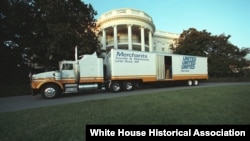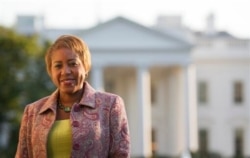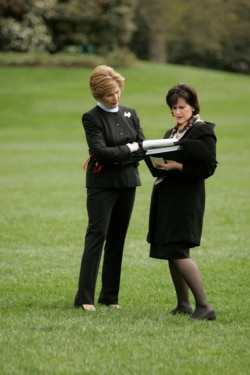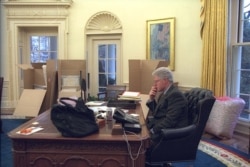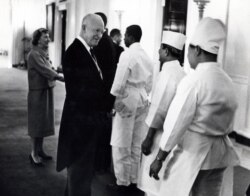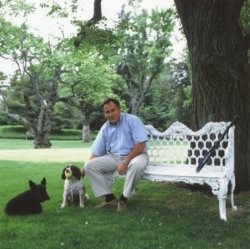As the presidency of Donald Trump wound down in the final days before Inauguration Day, parts of the West Wing accessible to the media looked increasingly vacant. Boxes and containers were packed with outgoing staffers’ personal belongings. Some White House aides posed for photos in the Rose Garden.
When President-elect Joe Biden is sworn into office January 20 at the U.S. Capitol, another critical component of the peaceful transfer of power will be underway, out of public view, about two miles away at the White House.
Inauguration Day is also moving day at the executive mansion. In just hours, the departing first family is moved out, and the executive mansion is cleaned and prepared for its newest residents.
“The ultimate goal of moving day is to gracefully bid farewell to the president and the first family and to, within five to six hours, flawlessly create a warm, welcoming living space that embodies home for the new president and family,” says Angella Reid, the former White House chief usher who oversaw moving day in 2017.
But moving day could look different this year. Before the Bidens move in, the White House, the scene of at least three COVID-19 outbreaks, will get a deep cleaning. There is no word on when the family will move into the executive mansion.
Planning ahead
Planning for the big day traditionally begins months in advance. The transformation is carefully organized. CNN reports that first lady Melania Trump has already sent several shipments to the Mar-a-Lago resort in Florida where the Trumps are expected to move after the president leaves office.
CNN also reported that White House chief usher Timothy Harleth, who previously worked at Trump’s Washington hotel, is consulting with the Biden team to facilitate move-in day for the incoming president.
Traditionally, the incoming first family chooses furnishings and artwork ahead of the move from the White House’s extensive collection, which is stored in a Maryland warehouse. They will have also noted their personal preferences when it comes to things like meals, snacks, beverages, bedsheets and towels.
Reid describes the day as a tightrope walk.
“It is highly planned for, highly organized and carefully choreographed,” she says. “It's a fast-paced, highly energized, euphoric sort of experience.”
Anita McBride has worked for three presidential administrations. As chief of staff to first lady Laura Bush, McBride knows firsthand what Biden and first lady Jill Biden can expect on Day One.
“When they come into the White House for the first time after traditionally, the inaugural parade, all their clothes are hanging in the closet. All of their personal photos are out in the places where they wanted them to be. It is really an amazing transfer,” she says.
The White House staff does whatever it can ahead of time to facilitate the smooth transfer from one first family to the next. For example, some painting and other upgrades are done when the outgoing president is away for the holidays in late December. But the rest is accomplished on moving day.
Two elevators bear the brunt of moving one president’s furnishings out while the new commander in chief’s belongings are moved in. Some of the bulkier items are carried up and down the stairs.
“There are so many areas that are painted. Artwork has to be changed out. Fixtures are changed, for the bathroom fixtures, lighting fixtures, new beds, new mattresses. Everything,” Reid says. “It's just a lot of moving parts.”
The incoming president makes choices about how to furnish the Oval Office. Most presidents choose to use the HMS resolute desk, given to President Rutherford B. Hayes by Queen Victoria in the late 1800s.
“Interestingly enough, the rug really has a role to play to convey the feelings that a president has or the emotions that they have about sitting in that office,” McBride says. “Of course, the portrait of George Washington always has its prominent place above the fireplace, and virtually no one has changed that.”
White House curators make sure government property does not leave with the outgoing family. Everything is tagged, separating a president’s private property from pieces that belong to the country. Former President Bill Clinton returned $28,000 worth of gifts amid confusion over whether the donated items were given personally to the Clintons or were intended for the White House collection.
Emotional day
Emotions can run high when the staff has to say goodbye to the first family.
“They feel this huge sense of loss, because you have built relationships with a lot of people, and it's finite,” Reid says. “You recognize a day is coming or has come, that these bonds will be severed.”
McBride recalls the emotion of leaving the White House.
“The relationship between a permanent staff and a first family, and particularly if there are children involved, and young children involved, they do become quite close,” she says. “And it's hard for them to say goodbye.”
That sense of loss can extend to people like veteran staffer Dale Haney, who looks after the first family’s pets.
“He is in charge of the grounds,” McBride says, “but he also has had the responsibility of taking care of any family pet. ... It's been a difficult experience for him on moving day when the pets that he's gotten so close to, who were like his family, when they leave with the first family.”
Leaving the White House can be especially difficult for a one-term president, as McBride experienced when George H.W. Bush lost the 1992 presidential election to Clinton.
“You feel a sense of, ‘I didn't get everything done the way that I had hoped,'” McBride says. “When you're leaving after four years, and particularly for a first family, it is emotional. And, you know, George H.W. Bush did say in his memoirs, it hurt. It hurt. And (his wife) Barbara Bush felt it, too. The family felt it deeply, but they also are incredible patriots, and they rose to the occasion.”
For White House staffers like Reid, Inauguration Day can last 21 hours, but the sense of mission and duty to the country overrides any fatigue.
Reid says moving day at the White House is where the peaceful transfer of power truly begins and ends, adding that the dexterity, professionalism and quiet commitment of the residence staff makes the seamless transition possible.
“I think that's a very integral part of the entire day and the launch of the presidency,” she says. “It's such a meaningful and impactful day that nothing else supersedes the necessity of creating a positively memorable experience for everyone involved.”




